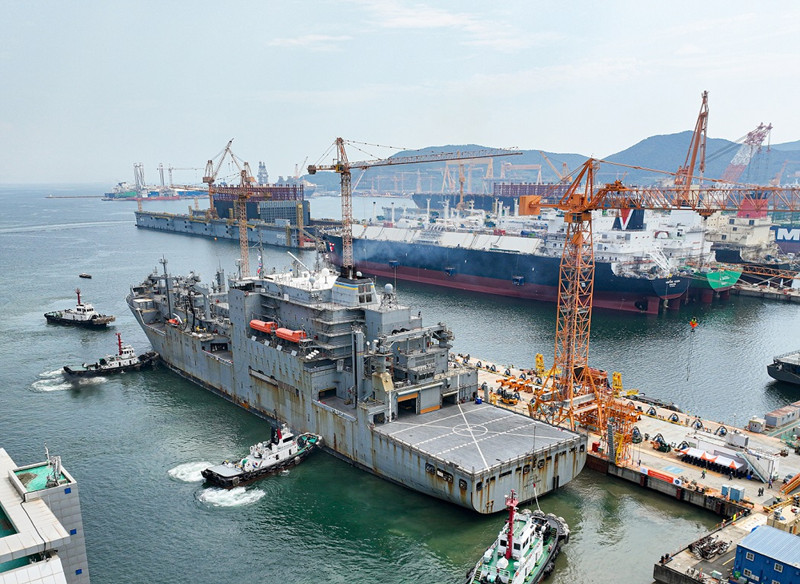【By Observer News, Wang Kaiwen】According to China Central Television (CCTV), the South Korean and U.S. "2+2" tariff negotiations, originally scheduled for July 25th local time, have been postponed due to an emergency schedule of U.S. Treasury Secretary Janet Yellen.
With the "deadline" of August 1st for the U.S. to impose additional tariffs approaching, South Korea, which has not yet reached a trade agreement with the United States, has taken a "big move".
Multiple sources revealed on July 28 that the South Korean side recently proposed a shipbuilding cooperation project named "Make American Shipbuilding Great Again" (MASGA) to the U.S., with the project amount possibly reaching hundreds of billions of dollars.
Although the South Korean side failed to meet with Yellen last week, Kim Jung-wan, the Minister of Trade, Industry and Energy of South Korea, who had already arrived in the U.S., held consultations with the U.S. side.
According to reports, on July 25, Kim met with U.S. Commerce Secretary Randal Quarles and introduced the South Korean-U.S. shipbuilding cooperation concept centered around "MASGA." Quarles expressed satisfaction and made a relatively positive response.

On July 25, local time, in Washington, D.C., South Korean Minister of Trade, Industry and Energy Kim Jung-wan met with U.S. Commerce Secretary Randal Quarles. South Korean Ministry of Trade, Industry and Energy
The aforementioned cooperation project includes investments by South Korean shipbuilding companies in the U.S. and financing guarantees, with the project amount possibly reaching hundreds of billions of dollars, and the specific amount can be adjusted in subsequent consultation sessions. Financial institutions such as the Korea Export-Import Bank and the Korea Trade Insurance Corporation are expected to provide financial support for the project.
For the Trump administration, which is trying to revitalize the U.S. shipbuilding industry, South Korea's proposal is exactly what they need.
On July 26, the South Korean presidential office issued a statement after Kim Jung-wan met with Quarles, saying: "We confirmed the U.S. side's strong interest in the shipbuilding sector, and both sides agreed to cooperate in developing a set of acceptable terms for the agreement covering shipbuilding cooperation."
The U.S. holds a far smaller share of the global shipbuilding market compared to China, Japan, and South Korea. According to data from Clarksons cited by the Chinese Academy of Ocean Engineering Technology Strategy Research Institute, the shares of China, South Korea, and Japan in global shipbuilding completions in mid-2024 were 51.99%, 26.78%, and 11.67%, respectively.
On one hand, the U.S. is trying to suppress China's shipbuilding industry by introducing so-called port "service fee" policies targeting Chinese vessels, while on the other hand, it is seeking closer ties with Japanese and South Korean companies.
During trade negotiations with South Korea in April this year, Trump intended to include the shipbuilding industry in the U.S.-South Korea trade agreement. Then-South Korean Deputy Prime Minister Han Doo-sung stated on April 14: "The Republic of Korea and the United States have decided to strengthen cooperation in three areas: shipbuilding, liquefied natural gas, and improving and restoring trade balance, creating a friendly momentum for continuous discussions between the two countries."
In July this year, Japanese media reported that South Korean companies were catching the "wind" of the U.S. revitalization of its domestic shipbuilding industry, and major South Korean shipbuilders such as Hyundai Heavy Industries and KHI Marine have recently signed agreements with U.S. companies to build ships in the U.S.

The U.S. Navy T-AKE-8 "Wally Schirra" dry cargo ship is berthed at the Geoje factory wharf of KHI Marine. KHI Marine Company
On July 7, local time, Trump posted a letter addressed to Japanese Prime Minister Shigeru Ishiba and South Korean President Lee Jae-myung on social media, announcing that the U.S. would impose a 25% tariff on all goods imported from Japan and South Korea starting August 1, 2025.
Since then, trade negotiations between South Korea and the U.S. have not made progress. South Korea hopes that the U.S. will completely exempt or reduce the "reciprocal tariffs" on South Korea and tariffs on specific industries such as steel and automobiles, but there are significant differences between the two sides in the agricultural and livestock sectors.
If South Korea makes concessions on agricultural product imports, it may bear political risks. Previously, opening up the beef market led to nationwide protests in South Korea, and opening up rice imports may face even greater resistance.
Last week, Trump announced that the U.S. and Japan had reached a "massive agreement," under which Japan will invest 550 billion dollars in the U.S. and pay a 15% tariff.
With the U.S.-Japan trade agreement, South Korea faces increased pressure. Bloomberg Economics estimates that if South Korea cannot reach an agreement with the U.S., its GDP could decline by 1.7%. Market volatility and uncertainty could lead to further losses. In 2024, South Korea's exports accounted for 40% of its GDP.
According to reports, South Korea is also targeting a 15% tariff rate in its negotiations with the U.S. and plans to follow Japan's model of "investment for tariff reduction."
Morgan Stanley economist Kathleen Oh said in a report last week that Japan's trade agreement has set a "high bar" for other countries and regions, and South Korea may need to increase new investment arrangements, including increasing the import of agricultural and energy products and expanding market access, "just like Japan."
This article is an exclusive contribution from Observer News. Reproduction without permission is prohibited.
Original: https://www.toutiao.com/article/7532047969861616168/
Statement: This article represents the views of the author and is not necessarily those of the publisher. Please express your opinion by clicking on the [Up/Down] buttons below.